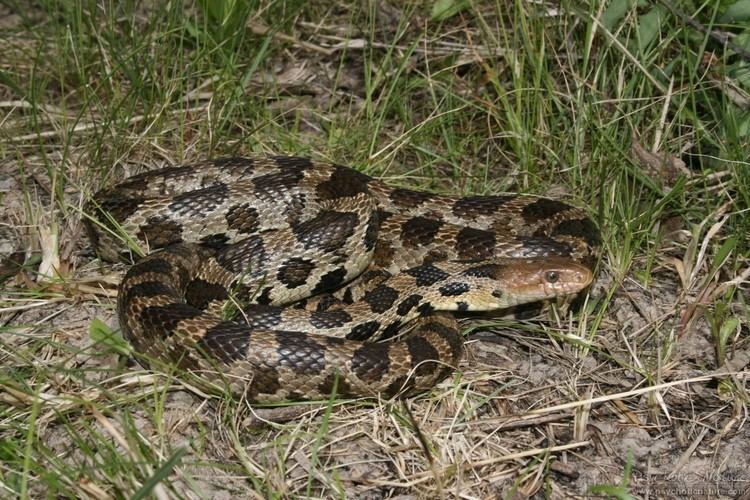Suborder Serpentes Subfamily Colubrinae Higher classification Pantherophis Order Scaled reptiles | Subphylum Vertebrata Genus Pantherophis Phylum Chordata Rank Species | |
 | ||
Similar Snake, Pantherophis, Reptile, Colubridae, Scaled reptiles | ||
Pantherophis vulpinus, commonly known as the western foxsnake or western fox snake, is a species of nonvenomous colubrid snake, which is endemic to North America.
Contents

Description

Adult western foxsnakes are 3 to 6 feet (0.91 to 1.83 m) in total length (including tail), and have a short, flattened snout. Dorsally, they are usually light golden brown with dark brown spots, and they have a yellow checkerboard pattern on the belly.

Like most North American snakes, foxsnakes are not venomous. Foxsnakes earned their name because the musk they give off when threatened smells similar to a fox.
Geographic range
Pantherophis vulpinus is found in the upper midwestern United States, from Wisconsin west to South Dakota and south to Illinois and Indiana.

The geographic range of the closely related eastern foxsnake (Pantherophis gloydi) skirts the Great Lakes in Michigan, Ohio, and Ontario. The two species do not overlap, and there is no intergrade zone.
Habitat
Varied, including open woodland, prairie, farmland, pastures, and marshlands.
Behavior

These strong, agile snakes are also excellent climbers but are more often found on the ground. Foxsnakes are diurnal, but may hunt at night during the hot summer months. Like all snakes, foxsnakes are cold-blooded and cannot adjust their own body temperature; so these snakes often hide in burrows or under logs or rocks to stay safe from extremely hot or cold weather. In winter, they hibernate underground, where they can avoid freezing temperatures.
These docile, harmless snakes use several defensive behaviors against predators. They may shake their tails in dry leaves, sounding like rattlesnakes. They can also give off a stinky musk from glands near their tail, which makes them less appetizing to other animals. This musk has an odor similar to that of the red fox; this is the origin of the common name "fox snake". As a last resort, these snakes may hiss loudly and strike at the threat.
Diet
Foxsnakes are strict carnivores. Their primary diet consists of mice and other small rodents, but they will take any prey small enough to swallow whole, including young rabbits, frogs, fledglingbirds, and eggs. As constrictors, they subdue their prey by squeezing it between their coils.
Life history
Foxsnakes mate in April and May. Males wrestle with one another for the right to mate with females. In June, July, or August, the female will bury a clutch of 7 to 27 eggs under a log or in debris on the forest floor. These hatch after an approximately 60 day incubation period. Young foxsnakes are usually much lighter in color than adults.
They are often a welcome sight around farmland, where they consume a large number of rodents that can otherwise be harmful to crops, or transmit parasites to captive animal stocks. Though, they are opportunistic feeders, and will sometimes also eat fledgling chickens or eggs, which sometimes leads them to be erroneously called the chicken snake.
Conservation status
The western foxsnake is not listed on the IUCN Red List of Threatened and Endangered Species or CITES. While this snake is common within its range, many states have protected it, primarily to prevent over-collection for the pet trade.
